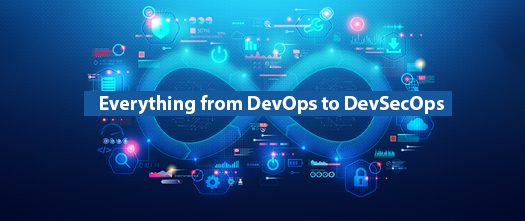Everything from DevOps to DevSecOps
In the ever-evolving world of IT, DevSecOps and DevOps are emerging as the superheroes of security and efficiency.
Imagine DevOps as the ultimate teamwork, where development and operations join forces to build software faster and better.
DevSecOps takes this further by ensuring security is embedded from day one, protecting applications from evolving threats.
Automation acts as the trusted sidekick, reducing manual effort and accelerating delivery. With DevOps and DevSecOps,
organisations can ship software faster, safer, and more cost-effectively.
If you’re looking for detailed insights into DevOps and DevSecOps, this blog provides clear explanations and practical
knowledge. These practices are not optional anymore—they are essential in today’s digital landscape.
Understanding DevOps
Let’s break down DevOps in a simple and practical way to understand how it transforms software development and operations.
Collaboration
DevOps promotes close collaboration between development and operations teams, breaking traditional silos and enabling
shared ownership and accountability.
Automation
Automation is a cornerstone of DevOps. It streamlines repetitive tasks, saves time, and allows teams to focus on innovation
and quality.
Continuous Integration and Continuous Delivery (CI/CD)
CI/CD pipelines automate building, testing, and deployment, enabling faster and more reliable software releases.
Benefits of DevOps
Faster and Reliable Software Delivery
DevOps accelerates release cycles while reducing failures through automation and consistent workflows.
Reduced Security Risks
Security checks integrated throughout development help identify vulnerabilities early and minimize cyber risks.
Improved Reliability and Scalability
Continuous monitoring and automation improve system stability and make scaling seamless as demand grows.
Lower Development and Operational Costs
Efficient automation reduces manual effort and operational expenses, freeing resources for strategic initiatives.
Challenges in Implementing DevOps
Cultural Resistance
Transitioning to DevOps requires a cultural shift that encourages collaboration, which can face resistance in
traditionally siloed organisations.
Skill Gaps
DevOps expertise is in high demand, making it challenging to find skilled professionals to lead initiatives.
Tool Integration
Integrating multiple DevOps tools into a cohesive workflow requires careful planning and technical expertise.
Security Concerns
Balancing rapid delivery with strong security controls remains a challenge without a structured approach.
Transitioning to DevSecOps
DevSecOps is the evolution of DevOps that embeds security into every phase of the software lifecycle—from design to deployment.
What is DevSecOps?
DevSecOps brings development, operations, and security teams together, making security a shared responsibility rather than
a final checkpoint.
Automation in DevSecOps
Automated security testing and remediation reduce risks while maintaining development speed.
CI/CD with Security
DevSecOps enhances CI/CD pipelines by embedding security checks that improve both speed and safety.
Integration of Security in DevOps
Shift-Left Security
Shift-left security focuses on identifying and fixing vulnerabilities early in development to prevent costly issues later.
Security Testing in CI/CD
Continuous testing ensures applications are evaluated for security risks before reaching production.
Static Application Security Testing (SAST)
SAST analyzes source code to detect vulnerabilities such as SQL injection and cross-site scripting.
Dynamic Application Security Testing (DAST)
DAST evaluates running applications to uncover runtime vulnerabilities like session hijacking and CSRF attacks.
Container Security Scanning
Container scanning identifies vulnerabilities in container images before deployment.
Compliance and Risk Management
DevSecOps ensures regulatory compliance while actively managing security risks across environments.
Security Culture and Training
A strong security culture supported by continuous training ensures every team member contributes to secure development.
How DevSecOps Differs from DevOps
Focus
- DevOps: Emphasizes development and delivery efficiency.
- DevSecOps: Extends focus to include security across the lifecycle.
Security Integration
- DevOps: Often treats security as a later-stage activity.
- DevSecOps: Embeds security from the beginning.
Team Structure
- DevOps: Unites development and operations.
- DevSecOps: Combines development, operations, and security teams.
Tools and Practices
- DevOps: Automates development and delivery workflows.
- DevSecOps: Adds automated security tools into those workflows.
Speed vs. Security
- DevOps: Prioritizes speed and agility.
- DevSecOps: Balances speed with strong security.
Compliance and Risk
- DevOps: Handles compliance separately.
- DevSecOps: Integrates compliance and risk management directly.
Future Trends of DevSecOps
The future of DevSecOps is driven by innovation and automation as organisations adopt unified DevSecOps platforms
that simplify secure software delivery.
Embracing DevSecOps Platforms
Unified DevSecOps platforms are gaining popularity, enabling teams to integrate security seamlessly while maintaining
speed and efficiency.






